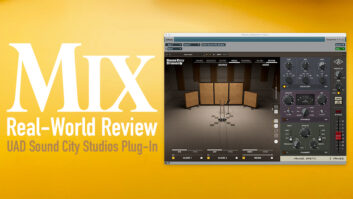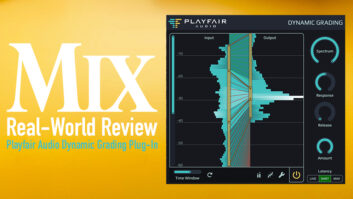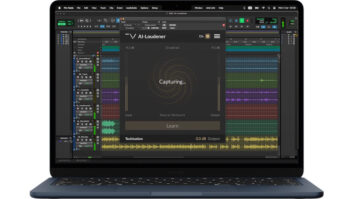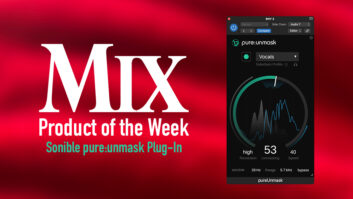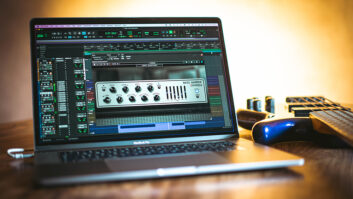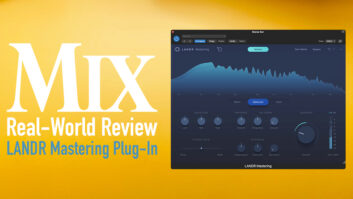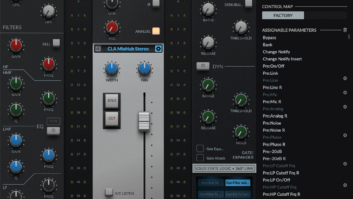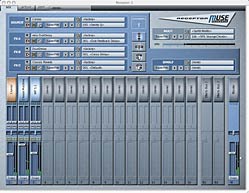
In the genus of digital audio effects and instruments, there are two species: dedicated hardware devices and computer-based software tools. It’s hard to place the Muse Research Receptor hardware audio effect/instrument plug-in player into just one of these categories — in fact, this product could very well be considered the platypus of digital Darwinism.
Receptor’s Mix window showing the plug-ins used for channel 1.
Receptor is a VST plug-in player running on a highly optimized hardware and software system. Although it’s based on a Linux/AMD architecture, it’s nothing like a conventional computer. You can play your guitar through its instrument-level input, riff out on a MIDI keyboard via its MIDI jacks, and run analog and digital audio signals through its ¼-inch stereo analog and S/PDIF I/O. It’s also equipped with an 8-channel ADAT Lightpipe output. On the back, in addition to the I/O, there are four more USB jacks, PS2 keyboard and mouse ports, an Ethernet jack and VGA video output.
The base system comes with 256 MB of RAM and a 160GB hard drive, and includes many freeware plug-ins and some commercial demos. It’s upgradable to a maximum 2 GB of RAM and a 750GB hard drive, and can be custom-ordered preloaded with plug-ins.
TURN ME ON
Receptor only runs UniWire-compatible plug-ins; UniWire is available as a VST plug-in and will soon be available in Audio Units and VST formats. Check www.plugorama.com for information about specific plug-in compatibility and a UniWire overview.
The easiest way to think of Receptor is as a 16-part multitimbral sound module, although it can be used for other purposes. Each part can have its own MIDI-addressable instrument and three insert effect plug-ins. A master effects plug-in section can be accessed via aux sends. The interface for splitting and layering sounds across a MIDI keyboard, as well as adding effects, is conceptually identical to those found on Roland, Korg and Yamaha synths that have been out for nearly 20 years. Receptor’s immense advantage is its ability to apply this concept to third-party plug-ins. Each of these 16 parts can be assigned as individual sounds to various outputs or mixed together to create monster combinations.
Connecting a Cat-5 Ethernet cable between a computer and Receptor serves several purposes. The included Receptor remote-control software will run on most Mac or Windows computers. This allowed me to remotely access the same visual interface, but as a window on my laptop screen. Receptor also uses standard network file-sharing, protocols so I could easily view the contents of its hard drive from my Mac. Because the Receptor unit doesn’t have a CD drive, using a networked computer is the only way to install plug-ins and add content.
INTERFACING VIA UNIWIRE
The most compelling use of the Ethernet cable is an upgraded feature called UniWire, which allows Receptor to easily interface with most DAWs. UniWire turns the Ethernet cable into the equivalent of a 32-channel audio snake that also carries MIDI information. To allow a DAW to talk to Receptor, simply insert the UniWire VST plug-in into a channel in the host software. The plug-in’s interface allows for intuitive routing to and from the various channels in Receptor. To test this, I used a pre-released Audio Units version of the UniWire plug-in in Logic Pro 7. I was impressed with how responsive UniWire felt when I played complex, layered virtual instruments with effects. While playing, Logic’s CPU monitor was completely dormant; in this application, Receptor can be thought of as an external DSP box.
I used an acoustic piano composition with orchestral accompaniment, which was produced in Logic Pro 7 on a Mac G5 with Vienna Symphonic Library’s Vienna Instruments. Using VSL is a DSP-intensive proposition, so when I tried to add any of the better-sounding acoustic piano plug-ins at the same time, it brought my computer to its knees. I employed Receptor by loading a demo version of EastWest’s PMI Bösendorfer 290 grand piano. By instantiating UniWire’s instrument plug-in on the MIDI-sequenced piano track, I quickly linked my G5 to Receptor and played everything in real time through Logic’s master output. Most surprising and impressive to me, the network connection was fast enough to keep up in live performance applications. Using an 88-note keyboard controller, I played the piano part through a MIDI interface into Logic over UniWire with no notable latency. Unfortunately, doing any offline bouncing or track-freezing within Logic was not possible, but real-time bouncing worked as expected.
POWER TO THE PRODUCERS
Receptor has enjoyed success with touring musicians who want to take plug-ins on the road and DAW users who want to beef up their native systems. Adding UniWire to the mix means that this new box better integrates closer with a DAW. Communication via Ethernet is instantaneous with Receptor acting like a locally hosted plug-in rather than an external box. The playing experience is quick and responsive, making Receptor blend invisibly into the production environment. It works so well, you may find yourself filling up those racks you cleared out just a few years ago.
Muse Research, 650/326-5400, www.museresearch.com.
Robert Brock is an engineer, educator, composer and pianist in the Phoenix area.
